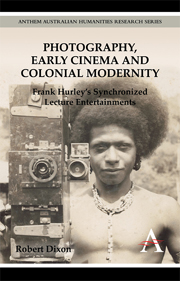Book contents
- Frontmatter
- Contents
- List of Illustrations
- List of Abbreviations
- Acknowledgements
- Introduction
- Chapter One The Home of the Blizzard: Douglas Mawson's Synchronized Lecture Entertainment
- Chapter Two Guided Spectatorship: Exhibiting the Great War
- Chapter Three Touring the Nation: Shackleton's ‘Marvellous Moving Pictures’ and the Australian Season of In the Grip of the Polar Pack-Ice
- Chapter Four Entr'acte: Sir Ross Smith's Flight, Aerial Vision and Colonial Modernity
- Chapter Five Colonial Modernity and Its Others: Pearls and Savages as a Multimedia Project
- Conclusion
- Notes
- Bibliography
- Index
Chapter Four - Entr'acte: Sir Ross Smith's Flight, Aerial Vision and Colonial Modernity
Published online by Cambridge University Press: 05 May 2012
- Frontmatter
- Contents
- List of Illustrations
- List of Abbreviations
- Acknowledgements
- Introduction
- Chapter One The Home of the Blizzard: Douglas Mawson's Synchronized Lecture Entertainment
- Chapter Two Guided Spectatorship: Exhibiting the Great War
- Chapter Three Touring the Nation: Shackleton's ‘Marvellous Moving Pictures’ and the Australian Season of In the Grip of the Polar Pack-Ice
- Chapter Four Entr'acte: Sir Ross Smith's Flight, Aerial Vision and Colonial Modernity
- Chapter Five Colonial Modernity and Its Others: Pearls and Savages as a Multimedia Project
- Conclusion
- Notes
- Bibliography
- Index
Summary
In War and Cinema (1988), the French critic Paul Virilio argues that the relationship between the development of cinema and contemporary military technologies, especially flight, is a definitive, indeed a constitutive feature of modernity. In his role as official photographer with the Australian War Records section in 1917–18, Frank Hurley became one of the first war photographers to experiment with aerial photography, using both still and cinema cameras. In particular, his experience flying with Captain Ross Smith of No. 1 Squadron Australian Flying Corps in Palestine in 1918 is exemplary of this early connection between aviation and photography. And in 1919, Hurley would again connect aviation and cinematography by his almost accidental involvement in the England-Australia air race or, as it became known, the Ross Smith flight.
Before the war had ended, the possibility of an air route connecting Australia to England was already being discussed in aviation journals. The Australian prime minister, W. M. Hughes, had flown a good deal between London and Paris during the peace discussions, and strongly favoured the idea. At his initiative, the Australian Commonwealth announced on 19 March 1919 that it would offer a £10,000 prize for the first Australian crew to fly from England to Australia within 720 hours and before 31 December 1919. By far the best aircraft available was the Vickers' Vimy bomber, and as no other pilot had anywhere near Ross Smith's experience with these large aircraft, Vickers invited him to fly their machine in the race.
- Type
- Chapter
- Information
- Photography, Early Cinema and Colonial ModernityFrank Hurley's Synchronized Lecture Entertainments, pp. 147 - 164Publisher: Anthem PressPrint publication year: 2012

